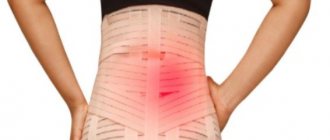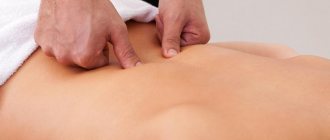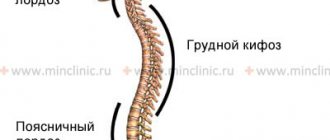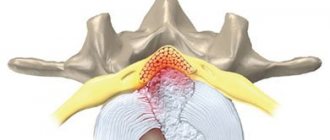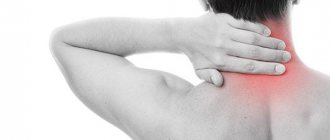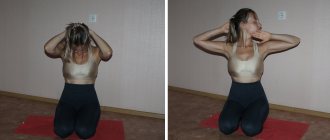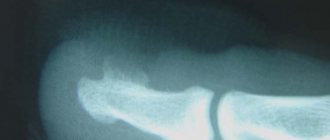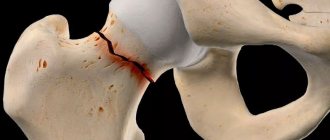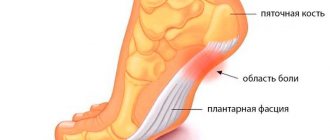Lumbosacral radiculitis is an inflammation of the nerve roots extending from the spinal cord at the level of the lumbar and sacrum (radix in Greek - “root”). The main causes of lumbosacral radiculitis are dystrophic changes in vertebral structures due to osteochondrosis.
This disease can be provoked by birth defects (sacralization), infectious lesions (tuberculosis, influenza), as well as injuries and hypothermia. Sometimes it develops as a complication of meningitis and encephalitis.
Lumbosacral radiculitis: symptoms
The leading symptom is pain of varying intensity. It can be aching and chronic, or it can be burning and sharp. Sometimes a painful attack occurs suddenly when a person tries to straighten his back, but it is not possible to do this completely, and new attempts only intensify the pain. An attack can begin after hypothermia, heavy physical labor, or staying in one position for a long time. The pain often radiates to the leg. In severe cases, the function of the pelvic organs is impaired.
Development mechanism
The spine is formed by vertebrae separated by intervertebral discs. In the middle is the spinal canal with the spinal cord inside: spinal nerves extend from it on opposite sides.
Some of them are responsible for motor functions, others for sensitivity. All of them pass through the foraminal openings and innervate different parts of the body and internal organs. If one or another nerve is compressed by pathological structures, a whole set of motor and sensory disturbances arise, which are typical signs of radiculitis.
Types of radiculitis
The disease can occur in any part of the spine. Depending on the location, there are three types of disease:
- Lumbosacral radiculitis. This is the most common type of disease. Causes of radiculitis in the lumbar region: protrusion and herniation of the intervertebral disc, arthritis, compression fracture.
- Cervical radiculitis. The disease develops in the cervical spine against the background of disc degeneration or protrusion, arthritis.
- Cervicothoracic radiculitis. This form of the disease is the least common due to the low mobility of the thoracic spine.
Which doctor should I contact?
Neurologists are involved in the diagnosis and treatment of radiculitis; if necessary, other specialized specialists are involved - vertebrologists, orthopedic traumatologists, and neurosurgeons. Complex therapy can be carried out with the participation of a chiropractor, physical therapist and reflexologist.
Possible complications of the disease
Acute radiculitis of the thoracic region, with untimely or inadequate treatment, becomes chronic. If pathological changes in the spine continue, the pain compresses the chest like a hoop. Further development of the causative disease - osteochondrosis - leads to intervertebral hernia.
Severe damage to nerve fibers is accompanied by loss of sensitivity, loss of certain motor skills and reflexes. If the roots innervating the diaphragm and intercostal muscles are affected, life-threatening breathing problems may occur.
The course of thoracic radiculitis is complicated by ischemia and spinal cord infarction due to prolonged compression of the radicular vessels and their blockage. The result is partial incapacity for work, disability.
How to recognize lumbosacral radiculitis
If a pinched nerve root is suspected, the doctor will order an x-ray, which is performed in frontal and lateral projections. With its help, intervertebral hernias, dislocations, fractures, defects and displacements of the vertebrae are identified. In order to exclude degenerative disorders in the spine, a spondylogram is performed. To confirm the infectious nature of the inflammation, a lumbar puncture is indicated, the results of which determine pathologies such as meningitis and encephalitis. Diagnostics may include MRI, CT scan of the spine, myelography, and laboratory blood tests.
Causes
- degenerative changes: osteochondrosis (protrusion, disc herniation), spondyloarthrosis, vertebral displacement (spondylolisthesis, spondylolysis)
- vertebral compression fractures due to osteoporosis or trauma
- problems with posture (scoliosis, kyphosis, lordosis);
- inflammatory process (spondylodiscitis, spondyloarthritis, rheumatoid arthritis, abscess)
- tumors;
The process can be triggered by: physical activity, hypothermia, lifting (carrying) heavy objects, a sedentary lifestyle and excess weight, pregnancy.
Drug treatment
Non-steroidal anti-inflammatory drugs (NSAIDs) are prescribed to relieve acute pain, inflammation and muscle spasms. These are drugs based on diclofenac, nimesulide, ibuprofen, meloxicam. The choice of dosage form depends on the intensity of the symptoms: severe pain is eliminated with intramuscular injections, moderate pain can be relieved with tablets. In the acute period, local agents - ointments, gels and creams - can additionally be used. The second choice drugs are steroids - Hydrocortisone, Dexamethasone, Diprospan. They have a powerful anti-inflammatory effect. If NSAIDs with hormones are ineffective, then therapeutic blockades with Lidocaine and Novocaine are performed.
Antispasmodics and muscle relaxants (Mydocalm) help relax spasmodic muscles. If swelling is present, diuretics and magnesium sulfate are prescribed. Swollen tissues put additional pressure on the nerve, so removing excess fluid greatly alleviates the condition. To enhance the effect of analgesics and normalize the functioning of the nervous system, sedatives are added. Treatment of lumbar radiculitis also includes B vitamins, which improve nerve conduction. The most commonly used are Milgamma and Neuromultivit. If the disease is of non-infectious origin, then ointments with a warming effect can be prescribed - based on turpentine, snake and bee venoms, camphor. They relieve pain due to local irritant action.
Treatment of radiculitis at home using the NANOPLAST forte therapeutic patch
used in the therapeutic treatment of radiculitis , such as NSAIDs, muscle relaxants, etc., certainly alleviate the patient’s condition, but with prolonged use they can cause harm to the body. And for some gastrointestinal diseases, many drugs are generally contraindicated.
But now it is possible to minimize side effects and at the same time increase the effectiveness of sciatica treatment. A new generation drug can help with this - the pain-relieving anti-inflammatory medical patch NANOPLAST forte .
In the treatment of radiculitis, the therapeutic plaster NANOPLAST forte in many cases shows very good results:
- helps relieve pain and inflammation,
- improve blood circulation in the affected area, which ensures active restoration of damaged tissues;
- makes it possible to reduce the dose of painkillers and anti-inflammatory drugs, and in some cases, cancel them altogether.
For radiculitis , the therapeutic plaster NANOPLAST forte is applied to the neck, cervico-brachial region, lower back or intercostal area - depending on the location of the pain. It is usually recommended to use the patch in the morning for 12 hours, but it can also be used at night. The duration of the course of treatment of radiculitis with a medicinal patch is from 9 days
High efficiency, absence of harmful side effects, long-term (up to 12 hours!) therapeutic effects, ease of use and affordable price make NANOPLAST forte the drug of choice in the treatment of radiculitis.
Read more about NANOPLAST forte
Non-drug treatment
Non-drug methods are used after the acute symptoms have subsided, when there is no longer severe pain. Their task is to strengthen the muscle corset, improve blood supply to the lumbosacral region and stimulate recovery processes. Help speed up recovery:
- physiotherapy – laser, ultraviolet, magnet, electrophoresis with painkillers, hormones, therapeutic mud;
- massage sessions using soft techniques to avoid re-pinching the nerve;
- special exercises that the physical therapy instructor will show help relieve excess stress from the spine and improve posture;
- reflexology;
- manual therapy;
- traction traction using dry or underwater methods.
Treatment of thoracic radiculitis using osteopathy
The method of therapeutic palpation for radiculitis compares favorably with manual therapy: it has no contraindications, is prescribed even during an exacerbation, has no side effects, and is easily tolerated by patients.
In cases of thoracic radicular syndrome, the opsteopath uses a structural technique, gently activating the back muscles, thereby normalizing their tone. When the vertebrae are displaced, a deeper impact is applied.
In the process of treating radiculitis, the osteopath achieves the following:
- Elimination of radicular symptoms and reduction of pain;
- Removing the inflammatory process in tissues;
- Improving blood circulation and metabolic processes in tissues affected by radiculitis;
- Restoring spinal mobility.
Patients with thoracic radiculitis, undergoing a course of osteopathy, need fewer medications and physiotherapeutic procedures.
After sessions of therapeutic palpation, the patient’s body is capable of self-regulation, and a healthy lifestyle will help avoid relapse of radiculitis.
Prevention
Preventive measures to prevent radiculitis are simple:
- competent organization of sleeping space. A comfortable bed is an elastic mattress of medium hardness and a small pillow of medium thickness. The ideal choice is orthopedic bedding;
- a complete and balanced diet will not only provide the body with healthy vitamins and minerals, but will also help maintain normal weight;
- adequate physical activity. Hard work is bad for your back, so if possible, you should reduce the load. Physical inactivity also threatens with negative consequences for the spine, and you should exercise at least once a week.
Doctors at our center have been working with patients suffering from radiculitis for many years. With timely treatment, the prognosis is always favorable. With us you will receive complete treatment, starting from examination and diagnosis, and ending with advice on lifestyle correction.
Folk remedies for radiculitis
Rubbing
- Mix 5-7 drops of lavender oil with 10 drops of any vegetable oil, heat the mixture slightly and rub into the inflamed area.
- Dissolve 25 grams of salt in 100 ml of alcohol, add a pod of hot pepper and 40 grams of pork fat. Keep all components in a water bath until the fat is completely melted.
- Burdock roots infused with alcohol. This tincture is sold ready-made in pharmacies and is inexpensive, but it has proven itself to be an excellent remedy for radiculitis.
First aid for exacerbation of radiculitis
In the acute stage of the disease, the patient needs strict bed rest for 1-2 days. The bed must have a hard orthopedic mattress for correct body position. In parallel with the lack of physical movements, drug therapy is important, which consists of using:
- anti-inflammatory drugs;
- painkillers;
- topical muscle relaxants (ointments, gels).
In the first days of exacerbation, physical activity is limited in order to minimize the load on the inflamed areas of the nerves and reduce the intensity of pain.
You can wear a supportive corset or belt to reduce the load on the vertebrae. If the pain does not go away, novocaine blockades are done.
